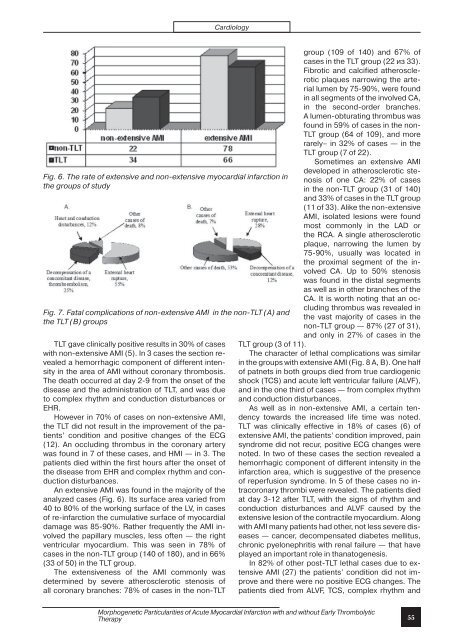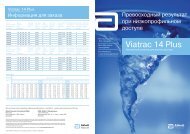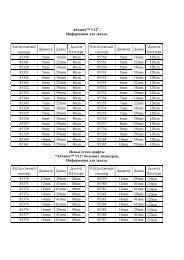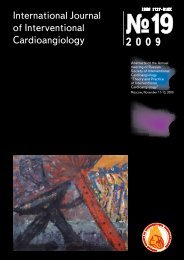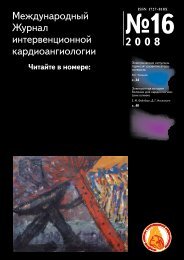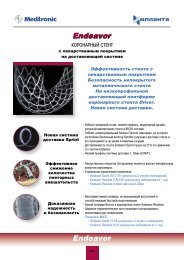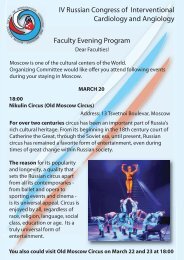Results of Coronary Stenting using the Stents with
Results of Coronary Stenting using the Stents with
Results of Coronary Stenting using the Stents with
Create successful ePaper yourself
Turn your PDF publications into a flip-book with our unique Google optimized e-Paper software.
Cardiology<br />
Fig. 6. The rate <strong>of</strong> extensive and non-extensive myocardial infarction in<br />
<strong>the</strong> groups <strong>of</strong> study<br />
Fig. 7. Fatal complications <strong>of</strong> non-extensive AMI in <strong>the</strong> non-TLT (А) and<br />
<strong>the</strong> TLT (B) groups<br />
TLT gave clinically positive results in 30% <strong>of</strong> cases<br />
<strong>with</strong> non-extensive AMI (5). In 3 cases <strong>the</strong> section revealed<br />
a hemorrhagic component <strong>of</strong> different intensity<br />
in <strong>the</strong> area <strong>of</strong> AMI <strong>with</strong>out coronary thrombosis.<br />
The death occurred at day 2-9 from <strong>the</strong> onset <strong>of</strong> <strong>the</strong><br />
disease and <strong>the</strong> administration <strong>of</strong> TLT, and was due<br />
to complex rhythm and conduction disturbances or<br />
EHR.<br />
However in 70% <strong>of</strong> cases on non-extensive AMI,<br />
<strong>the</strong> TLT did not result in <strong>the</strong> improvement <strong>of</strong> <strong>the</strong> patients’<br />
condition and positive changes <strong>of</strong> <strong>the</strong> ECG<br />
(12). An occluding thrombus in <strong>the</strong> coronary artery<br />
was found in 7 <strong>of</strong> <strong>the</strong>se cases, and HMI — in 3. The<br />
patients died <strong>with</strong>in <strong>the</strong> first hours after <strong>the</strong> onset <strong>of</strong><br />
<strong>the</strong> disease from EHR and complex rhythm and conduction<br />
disturbances.<br />
An extensive AMI was found in <strong>the</strong> majority <strong>of</strong> <strong>the</strong><br />
analyzed cases (Fig. 6). Its surface area varied from<br />
40 to 80% <strong>of</strong> <strong>the</strong> working surface <strong>of</strong> <strong>the</strong> LV, in cases<br />
<strong>of</strong> re-infarction <strong>the</strong> cumulative surface <strong>of</strong> myocardial<br />
damage was 85-90%. Ra<strong>the</strong>r frequently <strong>the</strong> AMI involved<br />
<strong>the</strong> papillary muscles, less <strong>of</strong>ten — <strong>the</strong> right<br />
ventricular myocardium. This was seen in 78% <strong>of</strong><br />
cases in <strong>the</strong> non-TLT group (140 <strong>of</strong> 180), and in 66%<br />
(33 <strong>of</strong> 50) in <strong>the</strong> TLT group.<br />
The extensiveness <strong>of</strong> <strong>the</strong> AMI commonly was<br />
determined by severe a<strong>the</strong>rosclerotic stenosis <strong>of</strong><br />
all coronary branches: 78% <strong>of</strong> cases in <strong>the</strong> non-TLT<br />
group (109 <strong>of</strong> 140) and 67% <strong>of</strong><br />
cases in <strong>the</strong> TLT group (22 из 33).<br />
Fibrotic and calcified a<strong>the</strong>rosclerotic<br />
plaques narrowing <strong>the</strong> arterial<br />
lumen by 75-90%, were found<br />
in all segments <strong>of</strong> <strong>the</strong> involved CA,<br />
in <strong>the</strong> second-order branches.<br />
A lumen-obturating thrombus was<br />
found in 59% <strong>of</strong> cases in <strong>the</strong> non-<br />
TLT group (64 <strong>of</strong> 109), and more<br />
rarely– in 32% <strong>of</strong> cases — in <strong>the</strong><br />
TLT group (7 <strong>of</strong> 22).<br />
Sometimes an extensive AMI<br />
developed in a<strong>the</strong>rosclerotic stenosis<br />
<strong>of</strong> one CA: 22% <strong>of</strong> cases<br />
in <strong>the</strong> non-TLT group (31 <strong>of</strong> 140)<br />
and 33% <strong>of</strong> cases in <strong>the</strong> TLT group<br />
(11 <strong>of</strong> 33). Alike <strong>the</strong> non-extensive<br />
AMI, isolated lesions were found<br />
most commonly in <strong>the</strong> LAD or<br />
<strong>the</strong> RCA. A single a<strong>the</strong>rosclerotic<br />
plaque, narrowing <strong>the</strong> lumen by<br />
75-90%, usually was located in<br />
<strong>the</strong> proximal segment <strong>of</strong> <strong>the</strong> involved<br />
CA. Up to 50% stenosis<br />
was found in <strong>the</strong> distal segments<br />
as well as in o<strong>the</strong>r branches <strong>of</strong> <strong>the</strong><br />
CA. It is worth noting that an occluding<br />
thrombus was revealed in<br />
<strong>the</strong> vast majority <strong>of</strong> cases in <strong>the</strong><br />
non-TLT group — 87% (27 <strong>of</strong> 31),<br />
and only in 27% <strong>of</strong> cases in <strong>the</strong><br />
TLT group (3 <strong>of</strong> 11).<br />
The character <strong>of</strong> lethal complications was similar<br />
in <strong>the</strong> groups <strong>with</strong> extensive AMI (Fig. 8 А, B). One half<br />
<strong>of</strong> patnets in both groups died from true cardiogenic<br />
shock (TCS) and acute left ventricular failure (ALVF),<br />
and in <strong>the</strong> one third <strong>of</strong> cases — from complex rhythm<br />
and conduction disturbances.<br />
As well as in non-extensive AMI, a certain tendency<br />
towards <strong>the</strong> increased life time was noted.<br />
TLT was clinically effective in 18% <strong>of</strong> cases (6) <strong>of</strong><br />
extensive AMI, <strong>the</strong> patients’ condition improved, pain<br />
syndrome did not recur, positive ECG changes were<br />
noted. In two <strong>of</strong> <strong>the</strong>se cases <strong>the</strong> section revealed a<br />
hemorrhagic component <strong>of</strong> different intensity in <strong>the</strong><br />
infarction area, which is suggestive <strong>of</strong> <strong>the</strong> presence<br />
<strong>of</strong> reperfusion syndrome. In 5 <strong>of</strong> <strong>the</strong>se cases no intracoronary<br />
thrombi were revealed. The patients died<br />
at day 3-12 after TLT, <strong>with</strong> <strong>the</strong> signs <strong>of</strong> rhythm and<br />
conduction disturbances and ALVF caused by <strong>the</strong><br />
extensive lesion <strong>of</strong> <strong>the</strong> contractile myocardium. Along<br />
<strong>with</strong> AMI many patients had o<strong>the</strong>r, not less severe diseases<br />
— cancer, decompensated diabetes mellitus,<br />
chronic pyelonephritis <strong>with</strong> renal failure — that have<br />
played an important role in thanatogenesis.<br />
In 82% <strong>of</strong> o<strong>the</strong>r post-TLT lethal cases due to extensive<br />
AMI (27) <strong>the</strong> patients’ condition did not improve<br />
and <strong>the</strong>re were no positive ECG changes. The<br />
patients died from ALVF, TCS, complex rhythm and<br />
Morphogenetic Particularities <strong>of</strong> Acute Myocardial Infarction <strong>with</strong> and <strong>with</strong>out Early Thrombolytic<br />
Therapy<br />
55


